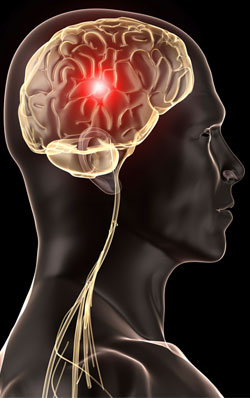
Brain aneurysm or cerebral aneurysm is a medical condition characterized by bulging of the walls of the blood vessels (artery and vein) of the brain. Cerebral aneurysms are not so uncommon about 27,000 cases are reported per year in the US alone.
In many cases brain aneurysms are silent (asymptomatic); incidentally diagnosed after brain scan done to investigate for other diseases. If present symptoms include severe headache, pain in the eyes, visual problems like double vision, blurring of vision etc, drooping of eye lids, confusion, convulsion even coma.
The most dreaded complication of cerebral aneurysm is rupture of the aneurysm leading bleeding in the brain. The consequent damage can occur in two ways; directly by the blood on the brain tissue and indirectly by increasing the pressure in the skull and thus cutting off blood supply to the brain tissue leading to brain stroke.
Causes
Like other aneurysms present on other blood vessels of the body, weakening of the wall of the blood vessel is the most important underlying factor for brain aneurysm. Usually these aneurysms appear in parts of the blood vessels where the walls are naturally weak especially at the points of branching.
Brain aneurysm can occur at any part of the arterial tree in the brain but most commonly it affects the arteries located at the base of the brain.
Brain aneurysms can be classified in several types depending upon size and shape of the said aneurysm. Aneurysms are considered to be small if the size is less than 15mm, large if the size is between 15 and 25mm, giant if the size is between 25 and 50mm and supergiant if the size is more than 50mm.
Depending on the shape aneurysms are either saccular, fusiform and microaneurysm.
In case of saccular aneurysm (also known as berry aneurysm), the aneurysm appears as round outpouching. This is the most common shape of brain aneurysm.
In case of fusiform aneurysm there is dilation of a part of an artery surrounding the entire blood vessel instead of dilation only at one side of the artery as in other forms of brain aneurysm. This type of brain aneurysms are less likely to be ruptured.
Microaneurysms also known as Charcot Bouchard aneurysms usually affect smaller blood vessels (diameter less than 300 mm). This type of brain aneurysm usually arises from the lenticulostriate vessels of the basal ganglia. This is one of the most common types of brain aneurysms which are prone to rupture. Chronic hypertension may lead to this type of brain aneurysm.
Risk Factor
There are several risk factors identified for brain aneurysm; some of these risk factors develop gradually over years while some are present since birth (congenital).
Risk factors which develop over years are advanced age, smoking, high blood pressure, atherosclerosis leading to loss of natural elasticity of the blood vessels, drug abuse especially cocaine, head trauma, chronic heavy alcohol drinking, fall in circulating estrogen levels after menopause in women, certain types of infections etc.
Risk factors present since birth (congenital) include congenital connective tissue disorder like Ehlers Danlos syndrome, polycystic kidney disease characterized by multiple cysts (fluid filled sac like structures) in the kidneys, abnormal narrowing of aorta (coarctation of aorta), family history of cerebral aneurysm, abnormal connection between artery and vein in the brain known as cerebral arteriovenous malformation etc.
Treatment
Surgery is the mainstay of treatment for both ruptured and unruptured brain aneurysm. Surgical options include
1. Surgical clipping; in this procedure the feeding blood vessel of the aneurysm is clipped by placing a metal clip.
2. Endovascular coiling: in this procedure a plastic catheter is placed in the vessels of the groin which then reaches the site of aneurysm through general blood circulation. The coil thus interrupts blood flow and leads to clot formation in that part of the vessel and ultimately seals off the aneurysm. This procedure is less invasive than surgical clipping hence considered safer initially however chance of re-bleeding and requirement of additional surgical interventions later is higher in comparison to surgical clipping.
Other associated treatments are
1. Drugs to relieve pain (pain killers), prevent convulsion (anti seizure drugs), occurrence of brain stroke due to poor blood supply (injection of vasopressor or angioplasty) etc.
2. Shunt surgery or placement of ventricular or lumbar draining catheters to drain excess cerebrospinal fluid (CSF) and relieve or prevent hydrocephalus.
3. Rehabilitation: physical, speech and occupational therapy is required in survivors of brain stroke following ruptured brain aneurysm
In most of the cases of unruptured brain aneurysms surgery is the cornerstone of treatment. In some cases of unruptured brain aneurysms the risks associated with surgery may outweigh the benefit hence in those cases decision is made based on certain factors. These are size, location of the aneurysm, age, general health status, family history, presence of congenital disease, if any etc.





